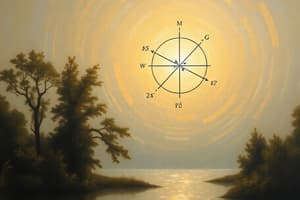Podcast
Questions and Answers
To find the circumference of a circle, you need to multiply the length of the diameter by pi (π) and divide the product by ______
To find the circumference of a circle, you need to multiply the length of the diameter by pi (π) and divide the product by ______
2
Both the area and circumference of a circle can be related to each other through the concept of ______
Both the area and circumference of a circle can be related to each other through the concept of ______
pi (π)
The formula for calculating the area of a circle is πr^2 / ______
The formula for calculating the area of a circle is πr^2 / ______
4
In construction, knowing the area and circumference of a circle can help determine the amount of material needed to make a circular structure, such as a ______
In construction, knowing the area and circumference of a circle can help determine the amount of material needed to make a circular structure, such as a ______
In healthcare, the area and circumference of a patient's limbs can be used to monitor ______ and oxygen levels
In healthcare, the area and circumference of a patient's limbs can be used to monitor ______ and oxygen levels
A circle is defined by its center point, which is also known as its ________
A circle is defined by its center point, which is also known as its ________
The ________ of a circle is twice the length of the radius
The ________ of a circle is twice the length of the radius
The formula to calculate the area of a circle involves squaring the value of pi (π), multiplying it by the square of the ________, and dividing the result by four
The formula to calculate the area of a circle involves squaring the value of pi (π), multiplying it by the square of the ________, and dividing the result by four
The area of a circle represents the total space enclosed by the boundary of the circle, calculated using the formula: Area = (πr^2) / ________
The area of a circle represents the total space enclosed by the boundary of the circle, calculated using the formula: Area = (πr^2) / ________
The ________ of a circle is the distance around its boundary
The ________ of a circle is the distance around its boundary
Flashcards are hidden until you start studying
Study Notes
Calculating Area and Circumference of a Circle
A circle is a basic geometric shape with several important properties. Two fundamental aspects of any circle are its area and circumference. These properties play pivotal roles in various mathematical calculations and real-world applications. Let's explore how these quantities can be determined and their interrelationships.
Properties of a Circle
Before diving into the specifics of calculating the area and circumference of a circle, it's essential to understand some basic properties of this shape. A circle is defined by its center point, which is also known as its radius. All points on the circle are equidistant from the center—this distance is precisely what we call the radius.

In addition to the radius, a circle has another critical dimension, called the diameter. Simply put, the diameter is twice the length of the radius; hence, all circles have only one unique diameter.
Calculating Area
The area of a circle represents the total space enclosed by the boundary of the circle. The formula to calculate the area of a circle involves squaring the value of pi (π), multiplying it by the square of the radius, and dividing the result by four. In other words:
Area = (πr^2) / 4
where r denotes the radius of the circle. So, given the radius, you can easily determine the area using this equation. For example, if a circle has a radius of 5 units, its area would be approximately 78.54 square units.
Calculating Circumference
To find the circumference of a circle, which is essentially the measure of the arc along the circle, you need to multiply the length of the diameter by pi (π) and divide the product by 2. Here's the formula:
Circumference = (D * π) / 2
where D stands for the diameter of the circle. Using our previous example where the diameter spans 10 units, the circumference of the circle will be around 31.42 units.
Relationship Between Area and Circumference
Both the area and circumference of a circle can be related to each other through the concept of pi (π). The area and circumference equations share a common denominator—pi. This means that as the ratio between the circumference and radius changes, so does the ratio between the area and radius.
As you increase the size of a circle (i.e., increase its radius), both the area and circumference grow at an increasing rate. Conversely, if you decrease the radius, the area and circumference decrease as well.
Formulas for Area and Circumference
To summarize, the formulas for calculating the area and circumference of a circle are as follows:
- Area:
πr^2 / 4 - Circumference:
(D * π) / 2
where r is the radius, D is the diameter, and π is pi.
Real-Life Applications
The area and circumference of a circle have numerous practical applications across various fields. In construction, for instance, knowing the area and circumference can help determine the amount of material needed to make a circular structure, such as a dome.
In manufacturing, the area and circumference can be used to calculate the size of a mold or template, ensuring a consistent shape and size in the production of circular parts.
In healthcare, the area and circumference of a patient's limbs can be used to monitor blood flow and oxygen levels.
Moreover, in geometry and trigonometry, understanding the area and circumference of a circle is crucial for solving problems involving similar triangles, right triangles, and other geometric shapes.
In summary, the area and circumference of a circle are fundamental concepts that play essential roles in various mathematical calculations and real-life applications. By understanding these properties, we can effectively explore the geometric properties of circles and solve problems in a variety of contexts.
Studying That Suits You
Use AI to generate personalized quizzes and flashcards to suit your learning preferences.




